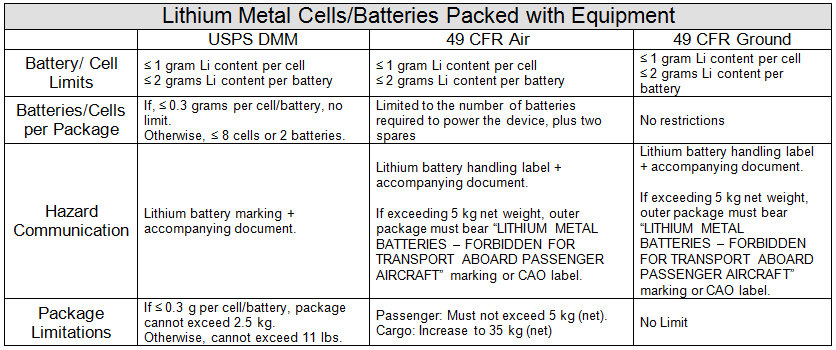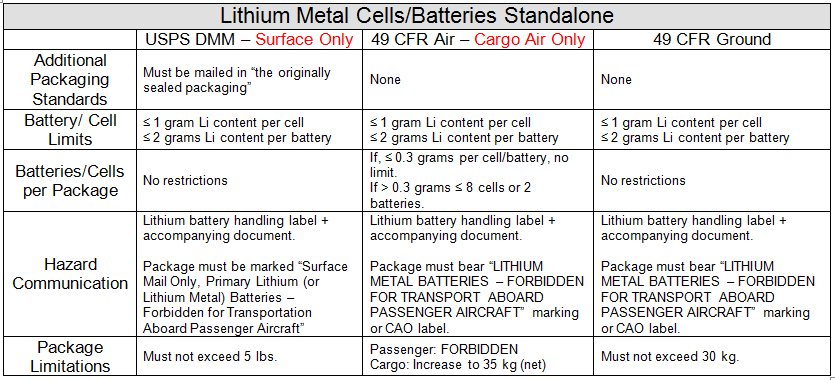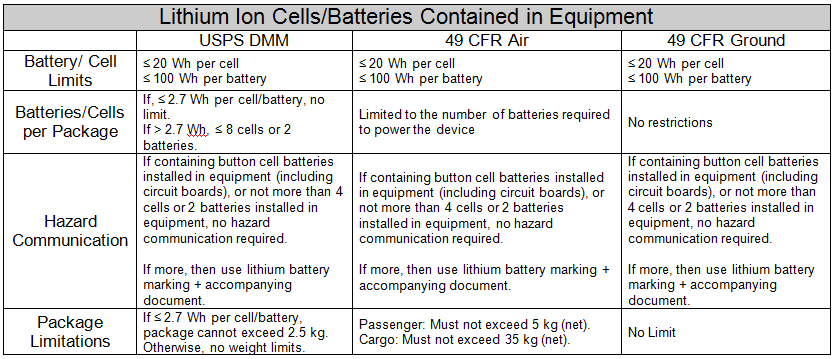I. Introduction
On Monday, January 26, 2015, the United States Parcel Service (USPS) published a notice in the Federal Register that describes revisions to USPS Publication 52, Hazardous Restricted, and Perishable Mail. These revisions closely align USPS requirements for shipping lithium cells and batteries with those found in both the U.S. D.O.T. and international regulations. The Publication 52 amendments take effect from March 2, 2015. The full text regulatory revisions were posted February 5, 2015 and can be viewed here.
II. Changes to USPS Standards
This revision significantly changed USPS requirements concerning the following:
- Marking: Packages containing standalone lithium cells or batteries, or lithium cells and batteries packed with or contained in equipment must be marked (lithium battery handling label is authorized) to:
- Indicate the packages contains “lithium metal” or “lithium ion” cells/batteries, as appropriate;
- Indicate the package is to be handled with care and that a flammability hazard exists if package is damaged;
- Indicate that special procedures must be followed in the event the package is damaged; and
- A telephone number for additional information.
- Note: The USPS will not require marking or documentation for button cell batteries installed in equipment, or no more than four (4) cells or two (2) batteries installed in equipment. However, for these shipment types, USPS will allow the optional use of the applicable lithium battery handling label in either domestic air or surface transport.
Note: If you choose to use the lithium battery handling label the dimensions and specifications must be as specified in 49 CFR 173.185.
- Documentation: In addition to package markings described above, packages containing standalone lithium cells or batteries, or lithium cells and batteries packed with or contained in equipment must be accompanied by a document that contains:
- An indication the packages contains “lithium metal” or “lithium ion” cells/batteries, as appropriate;
- An indication the package is to be handled with care and that a flammability hazard exists if package is damages;
- An indication that special procedures must be followed in the event the package is damaged; and
- A telephone number for additional information.
Note: A peel away document is authorized, see Labelmaster’s Peel Away Documents here
- Quantity Limitations: For domestic air, packages containing standalone lithium ion cells or batteries, or lithium cells or batteries packed with or contained in equipment, the mailpiece may not contain more than two (2) batteries or more than eight (8) cells.
- For domestic mailings the USPS is providing some practical relief for small consumer-type lithium metal cells or batteries (also called primary lithium cells or batteries) like those used to power watches, key fobs, cameras and flashlights. For lithium-ion cells and batteries with a watt-hour rating of not more than 2.7 Wh, or lithium metal batteries with lithium content no more than 0.3 grams as long as the mailpiece does not exceed 2.5 kilograms (5.5 pounds). There is no maximum number of cells or batteries per mailpiece.
Note: The new USPS quantity limitation language is not perfectly harmonized with DOT and international standards. Unlike USPS, when lithium batteries are packed with equipment, the DOT/International regulations allow for the package to contain the minimum number of batteries required to power the equipment, plus two (2) spares. In practice, this leads to circumstances where there are more than two (2) batteries or eight (8) cells per package.
- Definitions: Adding and revising definitions to more closely align with other transport regulations. The additions include:
- Describing lithium content with watt-hour rating, as is now industry standard.
- Separate shipping descriptions for lithium metal and lithium ion cells and batteries.
- International Prohibitions: These USPS revisions will prohibit packages required to bear the lithium battery handling label from being transported internationally. Although it is not required, marking of packages containing no more than four (4) lithium cells or two (2) lithium batteries contained in equipment is still acceptable for domestic air and surface transport. However, packages meeting the above circumstance will be prohibited from displaying lithium battery markings when mailed internationally.
Note: In the 49 CFR as well as international regulations, marking a package containing a hazardous material – even when not required – is still permissible. The USPS revisions will prohibit permissive marking for international shipments. Some companies choose to not take advantage of the package marking exception and apply the lithium battery handling label on packages that do not require them (e.g. a package containing a single laptop computer). These packages will not be authorized for international mail shipments.
III. USPS – PHMSA Direct Comparison
For USPS and PHMSA (DOT) lithium battery shipments, the following general standards apply:
- The cells and batteries must be of the type proven to meet the requirements of Part III, Subsection 38.3 of the UN Manual of Tests and Criteria;
- All cells and batteries must be protected from damage, short circuit, movement inside of the outer packaging;
- When lithium cells or batteries are contained in equipment, there must be a means in place to prevent accidental activation of the equipment; and
- The packaging must be a “strong outer packaging” that is capable of preventing crushing or exposure during normal circumstances of transportation
- Except when cells or batteries are contained in equipment, packaging must be capable of passing 1.2 meter drop test without damage to contents






